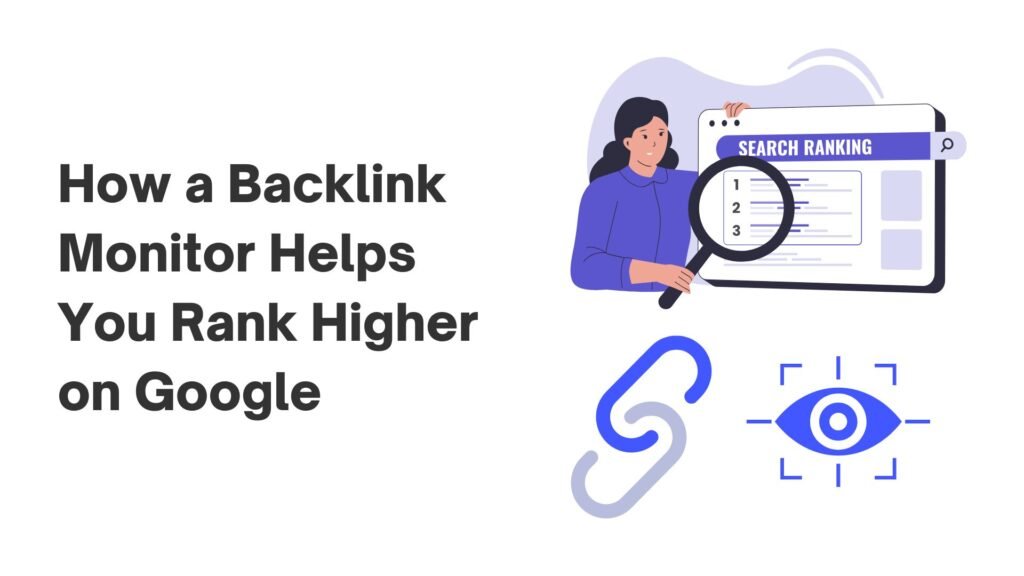
Do you know what is helping your competitors rank higher than you on Google?
It might not be better content. It might not even be a better keyword.
It could be their backlinks.
Backlinks are links from other websites that point to your website. They act like votes of trust. The more quality backlinks you have, the more search engines trust your site.
But here is the thing…
It is not just about getting backlinks. It is about keeping an eye on them too. That is where a backlink monitor comes in.
In this blog, we will talk about what a backlink monitor is, why it is important, and how it can boost your Google rankings fast.
Let us get started.
What Is a Backlink Monitor?
A backlink monitor is a tool that tracks the links pointing to your website.
Imagine it like a watchman. It keeps checking who is linking to you, which links are still live, which ones are gone, and if any new links have appeared.
With this tool, you can:
- Know when you gain or lose a backlink
- See if any link is broken or removed
- Check the quality of the sites linking to you
- Get alerts if there is any sudden drop or spike
This helps you stay in control.
Why Should You Monitor Your Backlinks?
You work hard to build backlinks. But what happens if they disappear without you knowing?
You lose rankings.
And you may never know why.
That is why monitoring backlinks is so important. Here is what a good backlink monitor can do for you:
1. Protect Your SEO Efforts
- You may have built 100 great backlinks.
- But if 40 of them get removed, you are in trouble.
- A monitor will alert you so you can act fast.
2. Find Toxic Links
- Not all backlinks help your rankings.
- Some may hurt them.
- A backlink monitor shows you poor-quality links, so you can disavow them.
3. Keep Your Link Profile Healthy
- A mix of dofollow and nofollow links is good.
- A monitor shows the balance.
- It helps avoid looking spammy in Google’s eyes.
4. Track Campaign Success
- If you are doing outreach or guest posting, a backlink monitor tells you if your links went live.
- No need to guess anymore.
How a Backlink Monitor Improves Google Rankings
Now let us get to the main point.
How does this simple tool help you rank higher on Google?
Here is how:
1. Helps You Stay Visible
When good backlinks are lost, your pages can drop in rankings.
If you catch those drops early, you can:
- Reach out to the site owner
- Replace the lost link
- Or build a new one fast
This keeps your visibility strong.
2. Helps You Build Better Backlinks
By monitoring who links to you, you can find:
- Which pages attract the most links
- Which type of content people love
- Which websites are open to linking
This data helps you focus on what works. You stop wasting time and energy.
3. Keeps You Ahead of Competitors
Many businesses never monitor their backlinks.
You can get ahead by:
- Knowing when competitors get new links
- Finding broken links on their site and replacing them with yours
- Keeping your own backlinks clean and updated
Real-Life Example
Let us say you run a small travel blog.
Last month, you wrote a post about hidden beaches in Thailand.
Two websites linked to your blog post. Great!
But after a few weeks, one of them deleted the post that had your link.
Without a backlink monitor, you would never know.
But with it?
You get an alert. You message the site owner. They fix the link.
Your rankings stay strong.
It is that simple.
Features To Look For in a Backlink Monitor Tool
Not all backlink monitors are the same. Some give only basic info. Others give deep insights.
Here are features you should look for:
- Live Link Tracking – This shows whether your backlink is still live or has been removed, helping you act quickly if it disappears.
- New and Lost Link Alerts – Get real-time email notifications when you gain or lose backlinks, so you never miss important changes.
- Anchor Text Analysis – See which words were used in the hyperlink. This helps you maintain a natural anchor text profile and avoid over-optimization.
- Domain Authority Check – Understand the credibility of the websites linking to you. High-authority links are better for SEO.
- Toxic Link Detection – Identify spammy or harmful backlinks that could damage your site’s rankings. A good tool should allow you to flag or disavow these quickly.
- Competitor Backlink Analysis – Find out who is linking to your competitors. This can uncover new opportunities for your own link-building strategy.
Look for a backlink monitoring tool that combines all these features to get the best results and maintain a healthy backlink profile.
Pick a tool that has these features.
Top Tools To Monitor Backlinks
You do not need to do this all manually. There are great tools that do the work for you.
Here are some options:
1. Ahrefs
- Powerful and detailed
- Shows new and lost links
- Gives link strength score
- Not free but worth the cost
2. SEMrush
- Good for tracking backlinks and keywords
- Alerts on toxic links
- Helps with disavow file creation
3. Monitor Backlinks
- Simple and easy to use
- Sends email reports
- Great for small businesses
4. Ubersuggest
- Budget-friendly
- Tracks new and lost backlinks
- Offers basic domain data
5. SEO SpyGlass
- Desktop-based
- Deep analysis of backlinks
- Offers competitor backlink reports
How To Use a Backlink Monitor Effectively
Getting a tool is step one. Using it well is step two.
Here is a simple plan:
Step 1: Add Your Website
Most tools ask for your website URL. Add it and let the tool start crawling your backlinks.
Step 2: Set Up Alerts
You can choose to get notified for:
- New backlinks
- Lost backlinks
- Changes in link status
Turn these alerts on.
Step 3: Analyze Link Quality
Do not just look at quantity. Check if the links are from trusted websites.
Low-quality backlinks may need to be disavowed.
Step 4: Monitor Competitors
Add your top 3 competitors.
See where they are getting backlinks from.
Can you get a link from the same site?
Step 5: Take Action
Lost a link? Contact the site and ask if they can re-add it.
Found a toxic link? Add it to your disavow list.
Bonus Tips
✅ Combine With Other SEO Tools – Use it alongside keyword trackers, content tools, and site audits for a full SEO picture.
✅ Review Anchor Text Often – Keep your anchor text varied and natural to avoid over-optimization.
✅ Set Monthly Reviews – Make backlink reviews a monthly habit to catch patterns early.
✅ Tag or Categorize Links – Tag backlinks by campaigns, source types, or content topics. This helps track what is actually working.
Using a backlink monitor the right way keeps your SEO strategy focused, proactive, and results-driven.
What To Avoid When Monitoring Backlinks
Here are the key things you should avoid when monitoring your backlinks:
1. Do Not Panic Over Lost Links
Backlinks drop sometimes—it’s normal. Before reacting, check if the lost link was high-quality, if it drove traffic, and whether the page still exists. Not all drops matter.
2. Do Not Chase Quantity Over Quality
More links don’t always mean better results. A single strong backlink can outweigh multiple low-quality ones. Focus on relevance, authority, and trustworthiness.
3. Do Not Ignore Nofollow Links
Nofollow links might not pass SEO juice directly, but they can still drive traffic, improve visibility, and build brand trust. Plus, search engines are getting smarter about interpreting them.
4. Do Not Rely Only on Tools
Tools like Ahrefs or SEMrush are helpful, but not flawless. They can miss links or mislabel them. Always verify important data manually.
5. Do Not Overuse Keyword Anchors
Repeating the same keyword-rich anchor text can look spammy to Google. Use natural phrases, branded terms, and a mix of variations to keep things healthy.
6. Do Not Trust Automated Reports Alone
Automated reports don’t show the full picture. They might miss the context or tone of referring content. Take time to review links manually.
7. Do Not Build Links Too Fast
Sudden spikes in backlinks can look suspicious. Aim for steady, natural growth, and avoid shady link schemes.
8. Do Not Ignore Competitors
Monitoring only your backlinks is not enough. Watch competitors too—they can reveal useful platforms and strategy gaps.
9. Do Not Analyze in Isolation
Always connect backlink data with rankings, traffic, and growth. SEO works best when seen as a whole.
10. Do Not Delay on Toxic Links
Bad links can damage your rankings. Investigate them early and disavow if needed to avoid penalties.
Final Thoughts
A backlink monitor is not just a tool.
It is your partner in ranking better on Google.
It saves you from losing your hard-earned links. It helps you build stronger ones. And it keeps your site in good shape.
Whether you are an SEO expert or a beginner, using a backlink monitor can make a big difference.
So, if you want to climb those search results and stay there, start monitoring your backlinks today.


